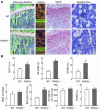PPARgamma insufficiency enhances osteogenesis through osteoblast formation from bone marrow progenitors
- PMID: 15067317
- PMCID: PMC362117
- DOI: 10.1172/JCI19900
PPARgamma insufficiency enhances osteogenesis through osteoblast formation from bone marrow progenitors
Abstract
Based on the fact that aging is associated with a reciprocal decrease of osteogenesis and an increase of adipogenesis in bone marrow and that osteoblasts and adipocytes share a common progenitor, this study investigated the role of PPARgamma, a key regulator of adipocyte differentiation, in bone metabolism. Homozygous PPARgamma-deficient ES cells failed to differentiate into adipocytes, but spontaneously differentiated into osteoblasts, and these were restored by reintroduction of the PPARgamma gene. Heterozygous PPARgamma-deficient mice exhibited high bone mass with increased osteoblastogenesis, but normal osteoblast and osteoclast functions, and this effect was not mediated by insulin or leptin. The osteogenic effect of PPARgamma haploinsufficiency became prominent with aging but was not changed upon ovariectomy. The PPARgamma haploinsufficiency was confirmed to enhance osteoblastogenesis in the bone marrow cell culture but did not affect the cultures of differentiated osteoblasts or osteoclast-lineage cells. This study demonstrates a PPARgamma-dependent regulation of bone metabolism in vivo, in that PPARgamma insufficiency increases bone mass by stimulating osteoblastogenesis from bone marrow progenitors.
Figures





Comment in
-
Fat's loss is bone's gain.J Clin Invest. 2004 Mar;113(6):805-6. doi: 10.1172/JCI21311. J Clin Invest. 2004. PMID: 15067310 Free PMC article.
References
-
- Beresford JN. Osteogenic stem cells and the stromal system of bone and marrow. Clin. Orthop. 1989;240:270–280. - PubMed
-
- Pittenger MF, et al. Multilineage potential of adult human mesenchymal stem cells. Science. 1999;284:143–147. - PubMed
-
- Bennett JH, Joyner CJ, Triffitt JT, Owen ME. Adipocytic cells cultured from marrow have osteogenic potential. J. Cell Sci. 1991;99:131–139. - PubMed
-
- Nuttall ME, Patton AJ, Olivera DL, Nadeau DP, Gowen M. Human trabecular bone cells are able to express both osteoblastic and adipocytic phenotype: implications for osteopenic disorders. J. Bone Miner. Res. 1998;13:371–382. - PubMed
-
- Park SR, Oreffo RO, Triffitt JT. Interconversion potential of cloned human marrow adipocytes in vitro. Bone. 1999;24:549–554. - PubMed
Publication types
MeSH terms
Substances
LinkOut - more resources
Full Text Sources
Other Literature Sources
Medical
Molecular Biology Databases

